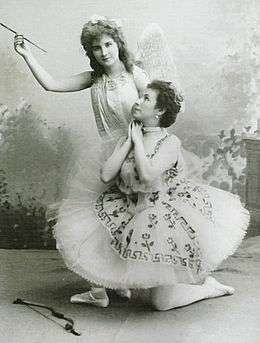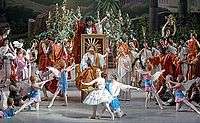Le Réveil de Flore
Le Réveil de Flore (en. The Awakening of Flora), (ru. «Пробуждение Флоры», Probuzhdenie Flory) is a ballet anacréontique in one act, with choreography by Marius Petipa and music by Riccardo Drigo, to a libretto written by Petipa and Lev Ivanov.[1] First presented by the Imperial Ballet at Peterhof Palace on 6 August [O.S. 25 July] 1894.
| Le Réveil de Flore | |
|---|---|
 Mathilde Kschessinskaya as the goddess Flora (right) and Vera Trefilova as the god Cupid (left) in the original production of Le Réveil de Flore, 1894. | |
| Choreographer | Marius Petipa |
| Music | Riccardo Drigo |
| Libretto | Marius Petipa and Lev Ivanov |
| Premiere | 6 August [O.S. 25 July] 1894 (Peterhof) 14 January [O.S. 2 January] 1895 (Imperial Mariinsky Theatre) St. Petersburg, Russia |
| Design | Mikhail Bocharov |
| Genre | Ballet anacréontique |
History
Le Réveil de Flore was produced for the celebrations held at Peterhof Palace in honor of the wedding of Emperor Alexander III's daughter the Grand Duchess Xenia to the Grand Duke Alexander Mikhailovich.[2] The ballet was soon transferred to the stage of the Imperial Mariinsky Theatre where it was first performed on 14 January [O.S. 2 January] 1895.[1] This performance took place during a farewell benefit for the ballerina Maria Anderson, who had been forced into early retirement after sustaining burn injuries in a theatre fire.[3]
The choreography for Le Réveil de Flore was erroneously credited as a joint effort between Marius Petipa and the Imperial Ballet's second Maître de ballet Lev Ivanov in the original printed theatre programme.[2] A review in the St. Petersburg Gazette of the first répétition générale also credited the choreography to both Petipa and Ivanov. This caused Marius Petipa to write a letter of correction to the newspaper:
In no. 201 of your much respected newspaper, a not fully accurate communication was reported about the production of the ballet Le Réveil de Flore. The programme of the ballet was created by L. I. Ivanov and me together, (but) the production of the dances and the mise-en-scène belong exclusively to me; Mr. L. I. Ivanov had no part in them.[1]
Riccardo Drigo's score was issued in orchestral partition and piano reduction by the music publisher Zimmerman in 1914.
The ballerina Anna Pavlova included an abridged version of Le Réveil de Flore in the repertory of her touring company. Conductor Richard Bonynge recorded Pavlova's abridged edition of Drigo's score for his 1974 LP "Homage to Pavlova" with the London Symphony Orchestra.[4]
2007 Reconstruction
Le Réveil de Flore was given its final performance in 1919.[1] Marius Petipa's choreography for the ballet was documented in the Stepanov method of choreographic notation very soon after its premiere in 1894, being among the first ballets to be recorded in this method. Today this notation is part of the Sergeyev Collection, held in Harvard University Library's theatre collection.
In 2005, the choreographer and historian Sergei Vikharev utilized this choreographic notation to stage a reconstruction of Petipa's original 1894 choreography for Le Réveil de Flore for the Mariinsky Ballet. The production also included a complete restoration of the original décor and costumes. Riccardo Drigo's score was restored from the original hand-written manuscript held in the archives of the Mariinsky Theatre's music library by conductor Pavel Bubelnikov with the assistance of the musicologists Lyudmila Sveshnikova and Elena Belyaeva.[5]
The production was first presented at the Mariinsky Theatre during the VIIth International Ballet Festival on 12 April 2007 at the Mariinsky Theatre, St. Petersburg. The principal dancers were Evgenia Obraztsova as the Goddess Flora, Xenia Ostreikovskaya as the Goddess Aurora, Svetland Ivanova as the Goddess Diana, Vladimir Shklyarov as the God Zephyr, Maxim Chaschegorov as the God Apollo, Valeria Martynyuk as the God Cupid, Alexei Timofeyev as the God Mercury and Daria Sukhorukova as the Goddess Hebe.[5]
Sergei Vikharev commented to the St. Petersburg Times that the ballet was "... like an ornate Fabergé egg." [6]
The production of Le Réveil de Flore was awarded the 2007 Golden Mask award.
Roles and original cast
| Role | St Petersburg 1894 |
|---|---|
| Flora, the Goddess of the Spring | Mathilde Kschessinskaya |
| Diana, the Goddess of the Moon | Olga Leonova |
| Aquilon, the God of the North Wind | Alexander Gorsky |
| Aurora, the Goddess of the Dawn | Anna Johansson |
| Apollo, the God of the Sun | Pavel Gerdt |
| Zephyr, the God of the West Wind | Nikolai Legat |
| Cupid, the God of Love | Vera Trefilova |
| Mercury, the Messenger of the Gods | Sergei Legat |
| Hebe, the Goddess of Youth | Claudia Kulichevskaya |
Résumé of dances and scenes
List of scenes and dances of Le Réveil de Flore taken from the piano score that was published in 1914.[7]
- №01 Prélude
- №02 L’apparition et danse de Diane–nocturne
- №03 L’apparition d’Aquilon
- №04 Scène et danse de la rosée–scherzo
- №05 L’apparition et scène d’Aurore
- №06 Valse de Flore, d’Aurore et des nymphes
- №07–a L’apparition d’Apollon
- №07–b Entrée et danse de Zéphyr
- №07–c Entrée et danse de Cupidon suivi des amours–pizzicato
- №08 Pas d’action—
- —a. Scène et Pas d'ensemble (cadenza for violin for Leopold Auer)
- —b. Variation de Zéphyr
- —c. Variation de Flore (cadenza for harp for Albert Zabel)
- —d. Grande valse-coda
- №09 L’arrivée et scène de Mercure, de Ganymède et d’Hébé
- №10 Grande marche–bacchanale
- №11 Grand pas
- №12 Galop générale
- №13 Apothéose: La révélation d’Olympe
- interpolation: Pizzicato d'Hébé (added after the 1894 premiere)
- interpolation: Variation d'Aurore (added after the 1894 premiere)
Libretto
Taken from the original published piano score of 1894.[7]
Tableau 1 — It is night. Flora, the goddess of Spring, is deep asleep with her nymphs; Diana, the goddess of Moon, guards their peace. With the approach of dawn, a freshness is felt in the air. Diana hides in the clouds.
Tableau 2 — Aquilon, the northern wind, rushes stormily over the locale; his cold breath of wind awakens Flora and forces her to seek refuge in the foliage. The appearance of chilling dew brings Flora to despair, and she implores Aurora, the goddess of the dawn, to help them.
Tableau 3 — Aurora consoles Flora with tender caresses and announces that Apollo, the god of day, who will end their sufferings, is following behind her. Aurora, Flora, and her nymphs perform a waltz.
Tableau 4 — With the appearance of resplendent Apollo, everything becomes animated. Smitten with the beauty of Flora, Apollo kisses her. At his call, Zephyr, the god of the gentle west wind, flies to his beloved Flora's embrace. He is followed by Cupid and her little amours. "You must be his helpmate," Apollo tells her, "It is the will of the gods." Everyone is delighted; Cupid, amours, and nymphs rejoice over the lover's happiness. A classical Pas d’action is performed.
Tableau 5 — Mercury, messenger of the gods, announces Hebé, the goddess of youth, and Ganymede, cupbearer to the gods. They present Flora and Zephyr a cup of nectar and proclaim that Jupiter has given them eternal youth.
Tableau 6 — A procession. The chariot of Bacchus and Ariadne is accompanied by bacchantes, satyrs, fauns, sylvans, and others. A Grand pas is performed by all assembled, followed by a rousing finale.
Apotheosis — Olympus is revealed; Jupiter appears, Juno, Neptune, Vulcan, Minerva, Ceres, Mars, Pluto, Proserpina, Venus, and others.
Gallery


The apotheosis "La révélation d’Olympe" from the Mariinsky Ballet's reconstruction of Le Réveil de Flore. St. Petersburg, 2007 
Mathilde Kschessinskaya as Flora (left) and Vera Trefilova as Cupid (right) costumed for Le Réveil de Flore, 1894. Frontispiece for the published piano reduction of Drigo's score for Le Réveil de Flore, 1914.
Footnotes
- Wiley, Roland John (1997). The Life and Ballets of Lev Ivanov. Oxford University Press. ISBN 978-0198165675.
- Celebration at Peterhof, Ezhegodnik Imperatorskikh Teatrov. St. Petersburg Imperial Theatres, 426-9. 1894.
- Wiley, Roland John (1985). Tchaikovsky's Ballets. Oxford University Press.
- Manchester, P. W. Liner note for the LP record "Homage to Pavlova" (CSA 2232). Decca Records. 1974.
- Souvenir program for the reconstruction of "The Awakening of Flora". State Academic Mariinsky Theatre. 2007.
- "The Awakening of Flora: The Mariinsky Ballet". Retrieved September 11, 2013
- Drigo, Riccardo Eugenio (1914). Piano score of "Le Réveil de Flore". Zimmerman.